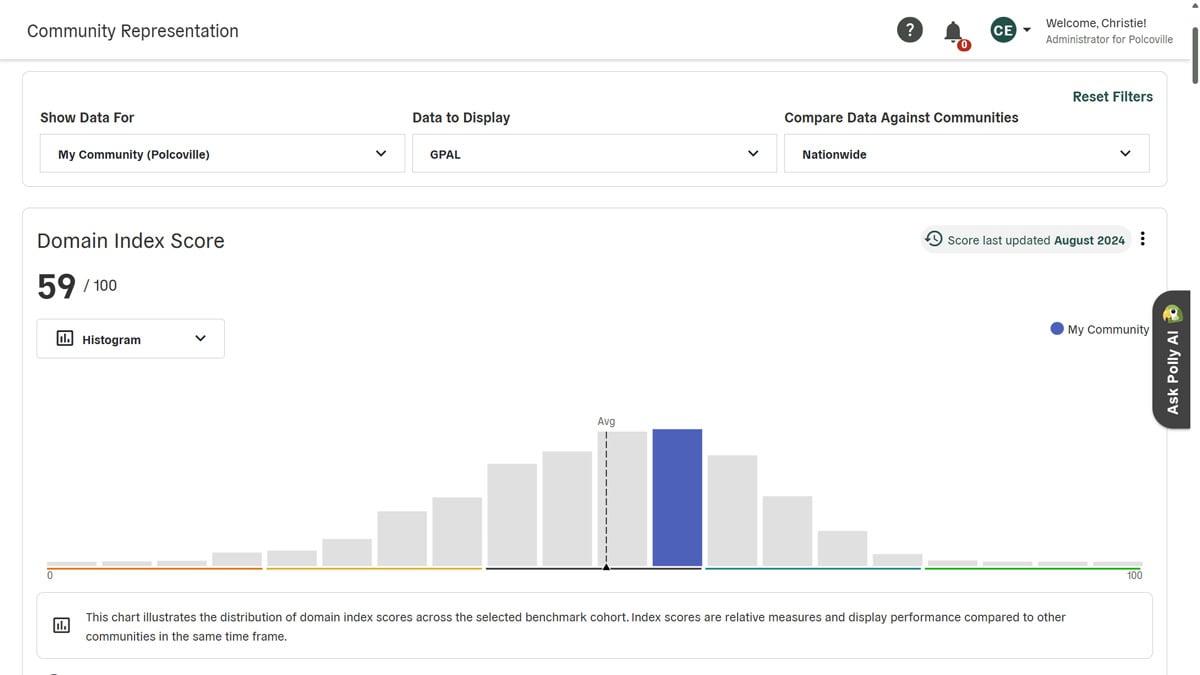Ten Most Important Community Livability Measures Governments Should Track (and Make It Easy)
By Polco on February 7, 2024

New community livability data empowers leaders to make decisions based on government performance.
Governments now have an easier way to measure the success of their community services and livability—without needing to hire a data scientist.
For the last 30 years, survey scientists at Polco’s National Research Center have provided data to local and state governments to improve community livability.
New data is now available in addition to the dozens of other quality-of-life indicators you can access on Polco. Polco scientists hand-selected each data point from hundreds of public sources like the US Census and the Bureau of Labor and Statistics.
“[The data] is vetted by legitimate experts in our field who are thinking about how to measure success,” said Aubrey Phillips, Strategic Planning and Performance Manager for Pinellas County, Florida.
The County used Polco data to streamline its strategic planning.
“I don’t know of many other communities that have been able to develop a community-wide strategic plan in such a brief period of time and so economically. Now we have a tool that will help us drive results that matter most to our community,” she said.
Governments also use the data to strengthen grant applications, inform decision-making, and craft better budgets.
The Model of Community Livability Measure
Polco’s scientists pioneered the Model of Community Livability, which is made up of the key areas that most influence quality of life.
- Economy
- Mobility
- Community Design
- Utilities
- Safety
- Natural Environment
- Parks and Recreation
- Health and Wellness
- Education, Arts, and Culture
- Inclusivity and Engagement
These domains are part of Polco’s Track data dashboards, which give governments curated information about their community’s performance without the hassle of data collection.
The data in the dashboards comes from Government Performance Action and Learning (GPAL), a collaboration of public, private, and academic partners who distill data into simple insights for government leaders.
New community livability data is now available on health and wellness, parks and recreation, natural environment, community design, mobility, and utilities. These new data points include:
- Number of unhoused individuals
- Broadband access
- Power outage frequency
- Water quality
- Voter registration and turnout
- Frequency and risk score of natural disasters like flooding, drought, tornado, etc.
- Average life expectancy
These data points empower municipalities to effectively make tough decisions as they face the current housing crisis, economic downturn, and increasingly extreme weather conditions.
The Database Expansion Reflects Current Trends Today’s Leaders Should Understand
“Every time we make new national datasets available for governments, the new data reflect current trends and changes in local government,” said Michelle Kobayashi, Principal Research Strategist at Polco.
Together, these data empower planners, city managers, area agencies on aging, law enforcement leaders, public works, and other government agencies to make decisions that improve community livability and quality of life. The database expansion gives governments curated, actionable information at their fingertips, with no data scientist required.
Governments use this data to inform strategic plans, strengthen applications for grant funding, align City Council and staff, prepare for council retreats, and make decisions about resource allocation.
“We’ve seen the many initiatives and community indicator projects that were emerging to help communities improve quality of life,” Kobayashi said. “Now we’ve put them all in one place for governments to easily access.”
Related Articles
Popular posts
Sign-up for Updates
You May Also Like
These Related Stories

Meet Grace: Your AI-Powered Grant Writing Assistant is Here to Save Time and Sanity

From Chaos to Clarity: Lead with Confidence Using Domain Scores


